| Western blot (WB): | 1:500-2000 |
| Immunohistochemistry (IHC): | 1:50-400 |
| Flow Cytometry (Fixed): | 1:50-200 |
| Enzyme linked immunosorbent assay (ELISA): | 1:100-1000 |
| (Boiling the paraffin sections in 10mM citrate buffer,pH6.0,or PH8.0 EDTA repair liquid for 20 mins is required for the staining of formalin/paraffin sections.) Optimal working dilutions must be determined by end user. | |
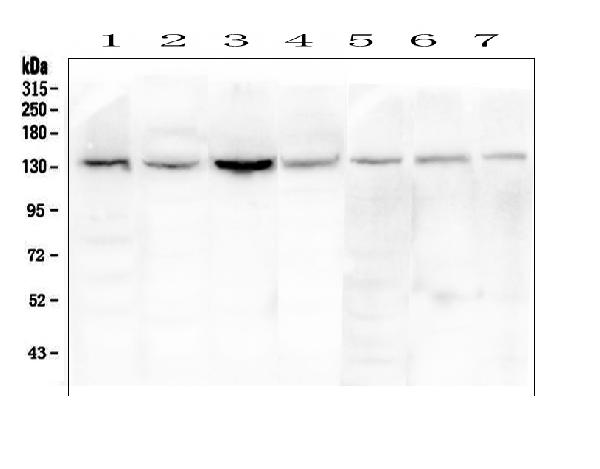
Western blot analysis of eNOS/NOS3 using anti-eNOS/NOS3 antibody (A01604-2). The sample well of each lane was loaded with 30 ug of sample under reducing conditions.
Lane 1: human placenta tissue lysates,
Lane 2: human K562 whole cell lysates,
Lane 3: human HepG2 whole cell lysates,
Lane 4: human THP-1 whole cell lysates,
Lane 5: rat kidney tissue lysates,
Lane 6: mouse kidne tissue lysates,
Lane 7: mouse small intestine tissue lysates.
After electrophoresis, proteins were transferred to a membrane. Then the membrane was incubated with rabbit anti-eNOS/NOS3 antigen affinity purified polyclonal antibody (A01604-2) at a dilution of 1:1000 and probed with a goat anti-rabbit IgG-HRP secondary antibody (Catalog # BA1054). The signal is developed using ECL Plus Western Blotting Substrate (Catalog # AR1197). A specific band was detected for eNOS/NOS3 at approximately 133 kDa. The expected band size for eNOS/NOS3 is at 133 kDa.
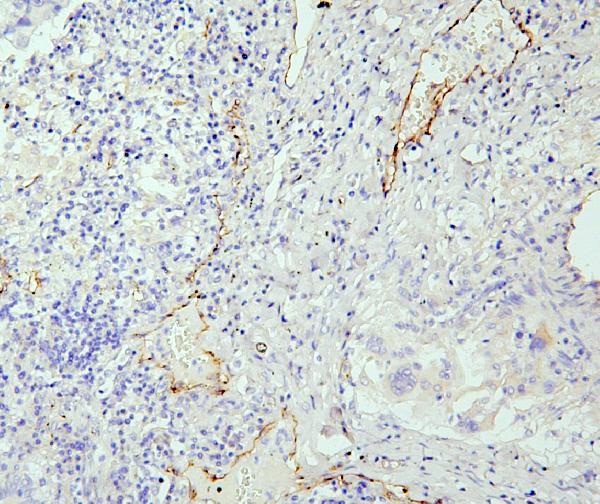
IHC analysis of eNOS/NOS3 using anti-eNOS/NOS3 antibody (A01604-2).
eNOS/NOS3 was detected in a paraffin-embedded section of human lung cancer tissue. Biotinylated goat anti-rabbit IgG was used as secondary antibody. The tissue section was incubated with rabbit anti-eNOS/NOS3 Antibody (A01604-2) at a dilution of 1:200 and developed using Strepavidin-Biotin-Complex (SABC) (Catalog # SA1022) with DAB (Catalog # AR1027) as the chromogen.
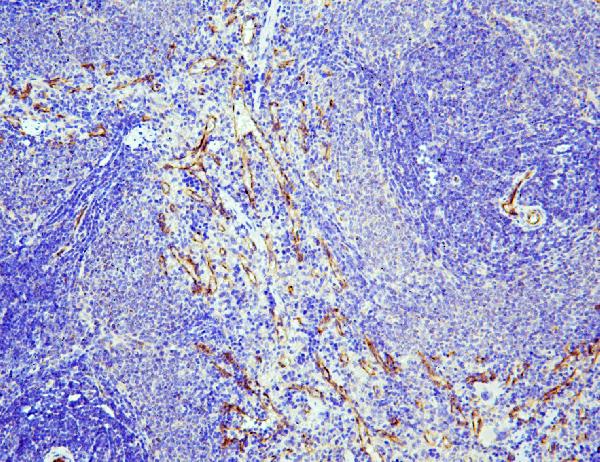
IHC analysis of eNOS/NOS3 using anti-eNOS/NOS3 antibody (A01604-2).
eNOS/NOS3 was detected in a paraffin-embedded section of rat spleen tissue. Biotinylated goat anti-rabbit IgG was used as secondary antibody. The tissue section was incubated with rabbit anti-eNOS/NOS3 Antibody (A01604-2) at a dilution of 1:200 and developed using Strepavidin-Biotin-Complex (SABC) (Catalog # SA1022) with DAB (Catalog # AR1027) as the chromogen.
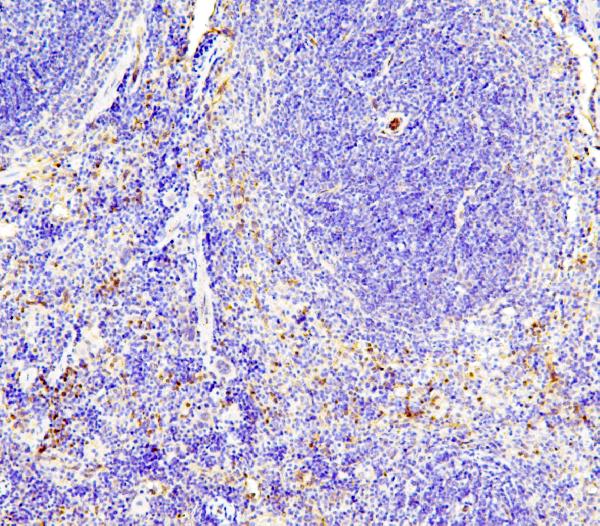
IHC analysis of eNOS/NOS3 using anti-eNOS/NOS3 antibody (A01604-2).
eNOS/NOS3 was detected in a paraffin-embedded section of mouse spleen tissue. Biotinylated goat anti-rabbit IgG was used as secondary antibody. The tissue section was incubated with rabbit anti-eNOS/NOS3 Antibody (A01604-2) at a dilution of 1:200 and developed using Strepavidin-Biotin-Complex (SABC) (Catalog # SA1022) with DAB (Catalog # AR1027) as the chromogen.
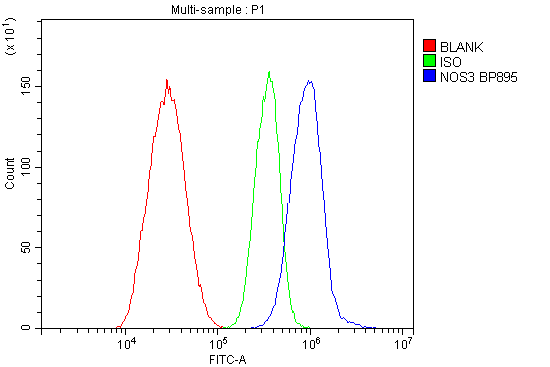
Flow Cytometry analysis of HepG2 cells using anti-eNOS/NOS3 antibody (A01604-2).
Overlay histogram showing HepG2 cells stained with A01604-2 (Blue line). To facilitate intracellular staining, cells were fixed with 4% paraformaldehyde and permeabilized with permeabilization buffer. The cells were blocked with 10% normal goat serum. And then incubated with rabbit anti-eNOS/NOS3 Antibody (A01604-2) at 1:100 dilution for 30 min at 20°C. DyLight®488 conjugated goat anti-rabbit IgG (BA1127) was used as secondary antibody at 1:100 dilution for 30 minutes at 20°C. Isotype control antibody (Green line) was rabbit IgG at 1:100 dilution used under the same conditions. Unlabelled sample without incubation with primary antibody and secondary antibody (Red line) was used as a blank control.

Western blot analysis of eNOS/NOS3 using anti-eNOS/NOS3 antibody (A01604-2). The sample well of each lane was loaded with 30 ug of sample under reducing conditions.
Lane 1: human placenta tissue lysates,
Lane 2: human K562 whole cell lysates,
Lane 3: human HepG2 whole cell lysates,
Lane 4: human THP-1 whole cell lysates,
Lane 5: rat kidney tissue lysates,
Lane 6: mouse kidne tissue lysates,
Lane 7: mouse small intestine tissue lysates.
After electrophoresis, proteins were transferred to a membrane. Then the membrane was incubated with rabbit anti-eNOS/NOS3 antigen affinity purified polyclonal antibody (A01604-2) at a dilution of 1:1000 and probed with a goat anti-rabbit IgG-HRP secondary antibody (Catalog # BA1054). The signal is developed using ECL Plus Western Blotting Substrate (Catalog # AR1197). A specific band was detected for eNOS/NOS3 at approximately 133 kDa. The expected band size for eNOS/NOS3 is at 133 kDa.

IHC analysis of eNOS/NOS3 using anti-eNOS/NOS3 antibody (A01604-2).
eNOS/NOS3 was detected in a paraffin-embedded section of human lung cancer tissue. Biotinylated goat anti-rabbit IgG was used as secondary antibody. The tissue section was incubated with rabbit anti-eNOS/NOS3 Antibody (A01604-2) at a dilution of 1:200 and developed using Strepavidin-Biotin-Complex (SABC) (Catalog # SA1022) with DAB (Catalog # AR1027) as the chromogen.

IHC analysis of eNOS/NOS3 using anti-eNOS/NOS3 antibody (A01604-2).
eNOS/NOS3 was detected in a paraffin-embedded section of rat spleen tissue. Biotinylated goat anti-rabbit IgG was used as secondary antibody. The tissue section was incubated with rabbit anti-eNOS/NOS3 Antibody (A01604-2) at a dilution of 1:200 and developed using Strepavidin-Biotin-Complex (SABC) (Catalog # SA1022) with DAB (Catalog # AR1027) as the chromogen.

IHC analysis of eNOS/NOS3 using anti-eNOS/NOS3 antibody (A01604-2).
eNOS/NOS3 was detected in a paraffin-embedded section of mouse spleen tissue. Biotinylated goat anti-rabbit IgG was used as secondary antibody. The tissue section was incubated with rabbit anti-eNOS/NOS3 Antibody (A01604-2) at a dilution of 1:200 and developed using Strepavidin-Biotin-Complex (SABC) (Catalog # SA1022) with DAB (Catalog # AR1027) as the chromogen.

Flow Cytometry analysis of HepG2 cells using anti-eNOS/NOS3 antibody (A01604-2).
Overlay histogram showing HepG2 cells stained with A01604-2 (Blue line). To facilitate intracellular staining, cells were fixed with 4% paraformaldehyde and permeabilized with permeabilization buffer. The cells were blocked with 10% normal goat serum. And then incubated with rabbit anti-eNOS/NOS3 Antibody (A01604-2) at 1:100 dilution for 30 min at 20°C. DyLight®488 conjugated goat anti-rabbit IgG (BA1127) was used as secondary antibody at 1:100 dilution for 30 minutes at 20°C. Isotype control antibody (Green line) was rabbit IgG at 1:100 dilution used under the same conditions. Unlabelled sample without incubation with primary antibody and secondary antibody (Red line) was used as a blank control.






